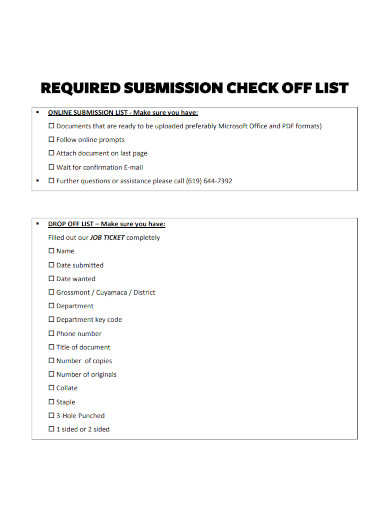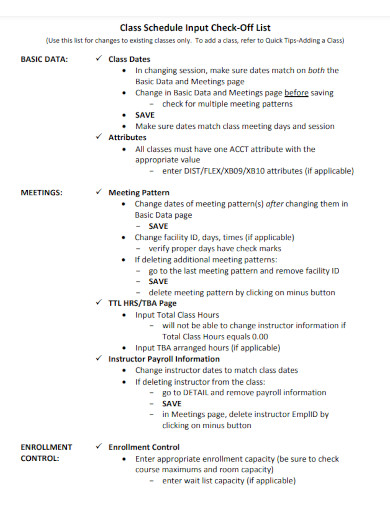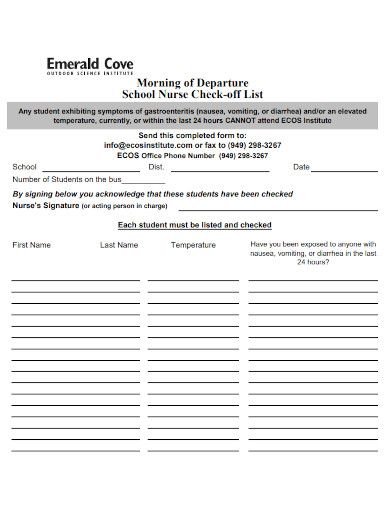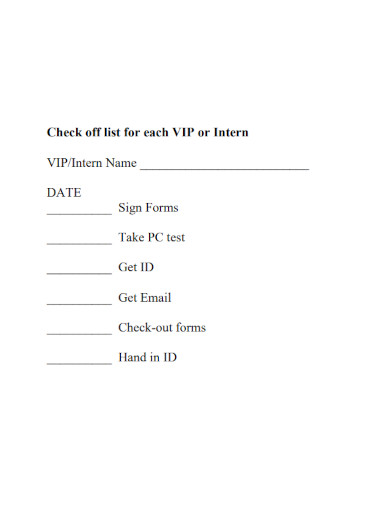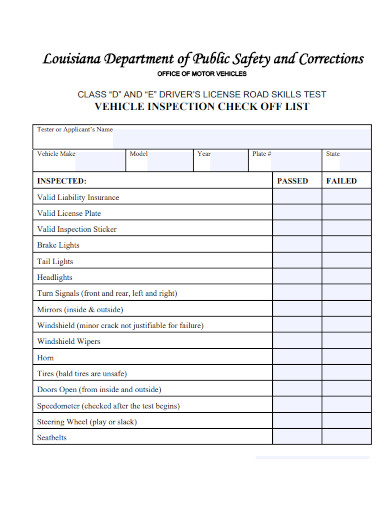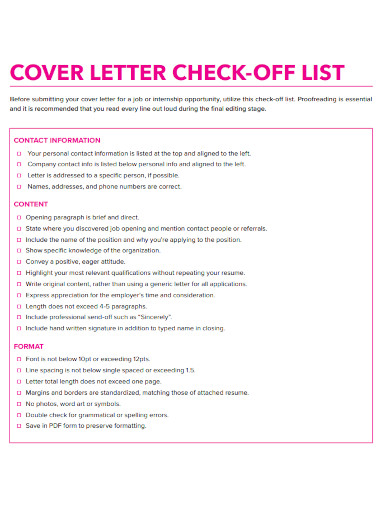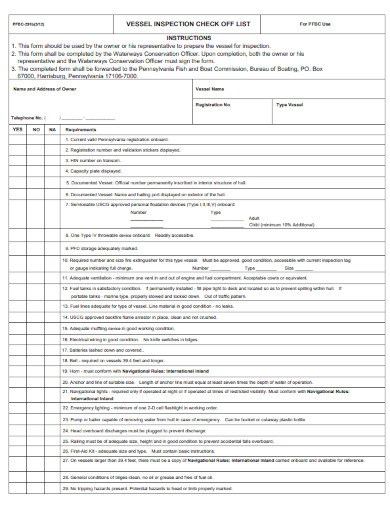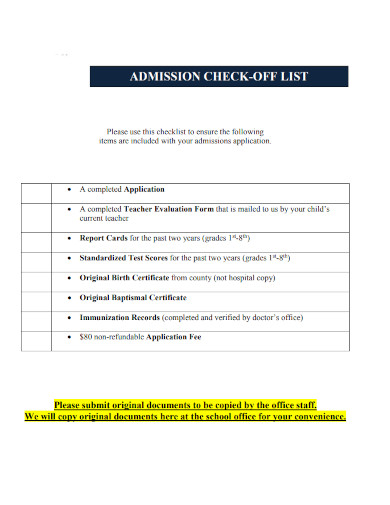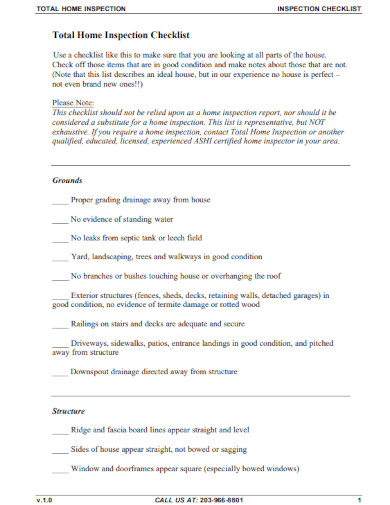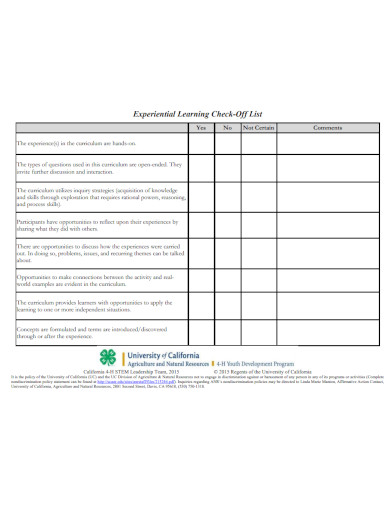Check-off lists can be used as a personal or professional purpose statement. For example, a college student could use a check-off list as a homework tracker for summer assignments, while a general manager could use one to track the progress of an executive project. They can also be used for short-term task lists, such as grocery shopping, or for long-term goals, such as saving for a retirement program.
10+ Check Off List Samples
1. Required Submission Check Off List
2. Class Schedule Input Check-Off List
3. Morning of Departure School Nurse Check-off List
4. Check-off List for Each VIP
5. Vehicle Inspection Check Off List
6. Cover Letter Check Off List
7. Vessel Inspection Check Off List
8. Communion Server Check Off List
9. Admission Check Off List
10. Home Inspection Check Off List
11. Experiential Learning Check-Off List
What Is a Check Off List?
A check-off list is a useful tool for keeping track of tasks and personal goals. By writing down tasks and marking them as complete, a person can stay organized and on top of their responsibilities. The act of checking off each daily task provides a sense of accomplishment and can help boost motivation.
How to Make a Check Off List?
Using a check-off list can also help with time management. By prioritizing tasks and focusing on one task at a time, a person can avoid distractions and complete their to-do list more efficiently. Additionally, having a visual representation of all the tasks can give a person a better understanding of what needs to be done and how much time is required. Making a detailed check-off list can involve the following steps:
Step 1: Determine the Purpose
Start by identifying the reason why you want to create the check-off list. Is it for personal or professional use? Is it for short-term or long-term goals? Knowing the purpose of the list will help you decide what to include. Write down all the tasks or goals that need to be completed, no matter how small or large.
Step 2: Prioritize and Categorized
Decide which tasks or goals are the most important, urgent, or need to be completed first. You can prioritize based on due dates, level of difficulty, or impact. If you have a large number of tasks or goals, consider grouping them into categories, such as work tasks, household chores, or personal goals.
Step 3: Create a Template
Choose a format for your check-off list, such as a piece of paper, a notebook, or a digital format. Make sure the template includes columns for the task or goal, its priority, its due date, and a checkbox for marking it as complete. Write each task or goal on the list, along with its priority and due date if applicable.
Step 4: Use Checkbox and Review
Add a checkbox next to each task or goal, so you can mark it as complete. Review regularly: Review your check-off list regularly, such as daily, weekly, or monthly, to keep track of your progress and make any necessary updates.
FAQs
What format should I use for my check-off list?
You can use any format for your check-off list that works best for you, such as a piece of paper, a notebook, or a digital format like a task management app.
How often should I review my check-off list?
It depends on your personal preferences and the tasks or goals on your list. Some people review their lists daily, while others review them weekly or monthly. Choose a frequency that works best for you and your schedule.
What happens when I complete all the items on my check-off list?
When you complete all the items on your check-off list, you can either create a new list or take a break and enjoy your accomplishments. Celebrating your successes can help boost your motivation and keep you on track.
In conclusion, check-off lists are a simple and effective way to stay organized and achieve goals. Whether used for personal or professional purposes, they can help increase productivity, boost motivation, and improve time management.
Related Posts
FREE 19+ Delivery Checklist Samples & Templates in MS Word ...
FREE 10+ Tenant Information Sheet Samples in PDF
FREE 13+ College Checklist Templates in PDF MS Word | Google ...
FREE 9+ Newborn Checklist Templates in Google Docs MS Word ...
FREE 9+ Daily Vehicle Checklist Samples [ Ambulance, Motor, Pre ...
FREE 5+ Retail Store Cleaning Checklist Samples in PDF MS Word
FREE 8+ Housekeeping Inspection Checklist Samples ...
FREE 15+ Sample Time Off Request Forms in PDF MS Word
FREE 10+ Vacation Checklist Samples in PDF Google Docs | MS ...
FREE 16+ Inspection Worksheet Templates in PDF Excel
FREE 8+ Quarantine Grocery List Samples [ Shopping, Healthy ...
FREE 8+ Chore List Samples in PDF MS Word | Excel
FREE 14+ Sample Event Checklist Templates in Excel MS Word ...
FREE 16+ Sample Packing Checklist Templates in Google Docs ...
FREE 8+ New Apartment Checklist Samples in Google Docs MS ...

